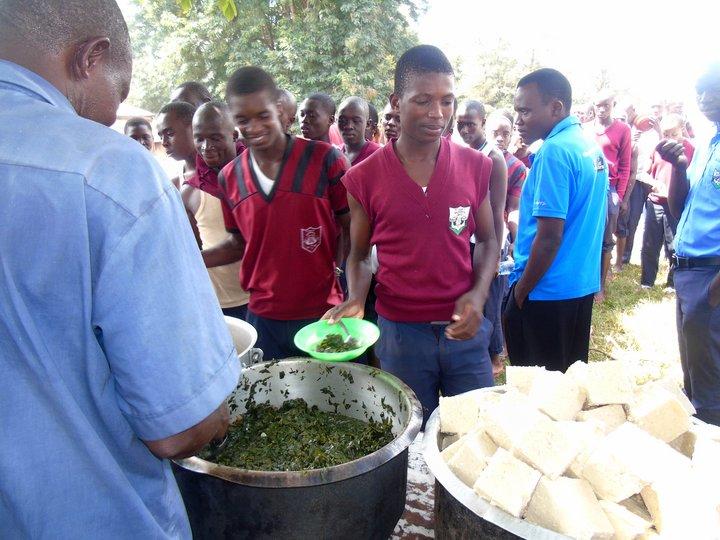Press and News A win-win-win solution for conservation, nutrition and livelihoods

A recent initiative by Bioversity International and partners was shortlisted as one of top ten innovative solutions that promote change in human activities to ensure sustainable food security while conserving biodiversity.
A recent initiative by Bioversity International and partners was shortlisted as one of top ten innovative solutions that promote change in human activities to ensure sustainable food security while conserving biodiversity.
Could it be that we already have the answers to some of the greatest conservation and development challenges? The international conservation organization Rare is determined to find out, and uncover them through their Solution Search competitions. These contests shed light on successful innovations in community-led conservation so that we can as Brett Jenks, CEO and President of Rare, puts it: “Find what works and repeat it”.
The Farming for Biodiversity Solution Search competition set out to document examples of what works on the ground against the threats posed to our ecosystems and biodiversity by unsustainable agricultural practices.1 The focus is on behaviour change, which is often inhibited by a lack of awareness of solutions and of the value of biodiversity in the agricultural sector.
Out of over 300 entrants, only ten solutions made it to the list of finalists. Among them, is an initiative facilitated by Bioversity International2 in Busia County in western Kenya, where malnutrition, and the detrimental effects of climate change and soil degradation abound.
The idea was to promote a sustainable food procurement model that targets indigenous vegetables and links local farmer associations to schools and school feeding. This was put into practice in Kenya where African leafy vegetables, which are affordable, nutritious and adapted to the local environments, were grown using sustainable agricultural methods.
With support from Bioversity International and partners, a farmer group negotiated an agreement with a school allowing the group to grow the vegetables on the school land and sell them to the school at an agreed market price. The vegetables thus serve to promote conservation of the local food biodiversity while improving livelihoods and nutrition quality in school meals. The pupils benefit from a healthy, diversified meal and the farmers enjoy the link to a dependable market with reduced transportation costs and food loss. Moreover, with the plot in the school’s vicinity it doubles up as an educational tool for students who learn about sustainable agriculture, optimal nutrition and get hands-on experience in growing and using local crops.
What started as a pilot project in mid-2016 is proving to be a successful win-win-win solution, simultaneously addressing consumer needs for greater nutrition, supply constraints linked to marketing, and local crop species conservation. So far, healthy school meals are being provided to approximately 5,500 pupils through 13 contracts. Additionally, one contract has been secured with a hospital. These contracts also ensure a steady income to about eight farmer groups.
 One farmer, Joyce Momanyi, found herself having to assume the role of sole breadwinner upon her husband’s passing. As growing and selling maize just wasn’t cutting it, she turned to African leafy vegetables, which grow faster and require less input. This decision transformed her life. Empowered, she formed a group of women farmers and together they underwent the marketing training offered by the project and managed to secure a contract with a school. She has since improved her household’s livelihood and is now venturing into seed production. Photo: Joyce during the training. Credit: SINGI One farmer, Joyce Momanyi, found herself having to assume the role of sole breadwinner upon her husband’s passing. As growing and selling maize just wasn’t cutting it, she turned to African leafy vegetables, which grow faster and require less input. This decision transformed her life. Empowered, she formed a group of women farmers and together they underwent the marketing training offered by the project and managed to secure a contract with a school. She has since improved her household’s livelihood and is now venturing into seed production. Photo: Joyce during the training. Credit: SINGI |
|---|
Perhaps even more important is the impact of awareness raising this has had on both the supply and demand side. On the demand side, the initiative helps build interest in local crops and awareness of the importance of diversity and nutrition in meals. Simultaneously, on the supply side, it sets out to improve farmers’ capacity in food production, business management and value addition to respond to the new and increasing market demand.
Consequently, this work has now been included as a Solution in the new Agriculture and Biodiversity portal – part of the PANORAMA-Solutions for a Healthy Planet initiative – launched last week at COP23 in Bonn.
The African leafy, and almost forgotten, vegetables were once perceived as food for the poor but thanks to these initiatives, they are now making a comeback. Schools hope to see less absenteeism due to sickness and diet-related diseases, and farmers – many of whom are women – are improving their economies. With the help of these portals and competitions, practitioners can now more easily learn from each other and replicate, adapt and scale up these successful approaches to other environments.
This work is carried out in collaboration with the CGIAR Research Program on Agriculture for Nutrition and Health and is supported by CGIAR Fund Donors.
Notes:
1 See a list of examples.
2 Critical support for this research has been received from the Australian Centre for International Agricultural Research (ACIAR) with additional support from the MacArthur Foundation. Key implementing partners include Sustainable Income Generating Investment (SINGI), CABE, the Busia County Ministry of Health, Ministry of Education, Ministry of Agriculture, and Kenya Agriculture and Livestock Research Organization (KALRO).
The Global Environment Facility (GEF) Biodiversity for Food and Nutrition initiative is led by Brazil, Kenya, Sri Lanka and Turkey and coordinated by Bioversity International, with implementation support from the United Nations Environment Programme (UNEP) and the Food and Agriculture Organization of the United Nations (FAO).
Also read African leafy vegetables go back to school in Kenya.
Find out more about the finalists and who took the prize.
Photo: Students in a school in Kenya, lining up for their school meal and selecting African leafy vegetables. Credit: Aurillia Manjella/BFN Kenya
